Fishing the Amazon’s Lau Lau Land
April 15, 2021



 Fishing,SCA Articles
Fishing,SCA Articles
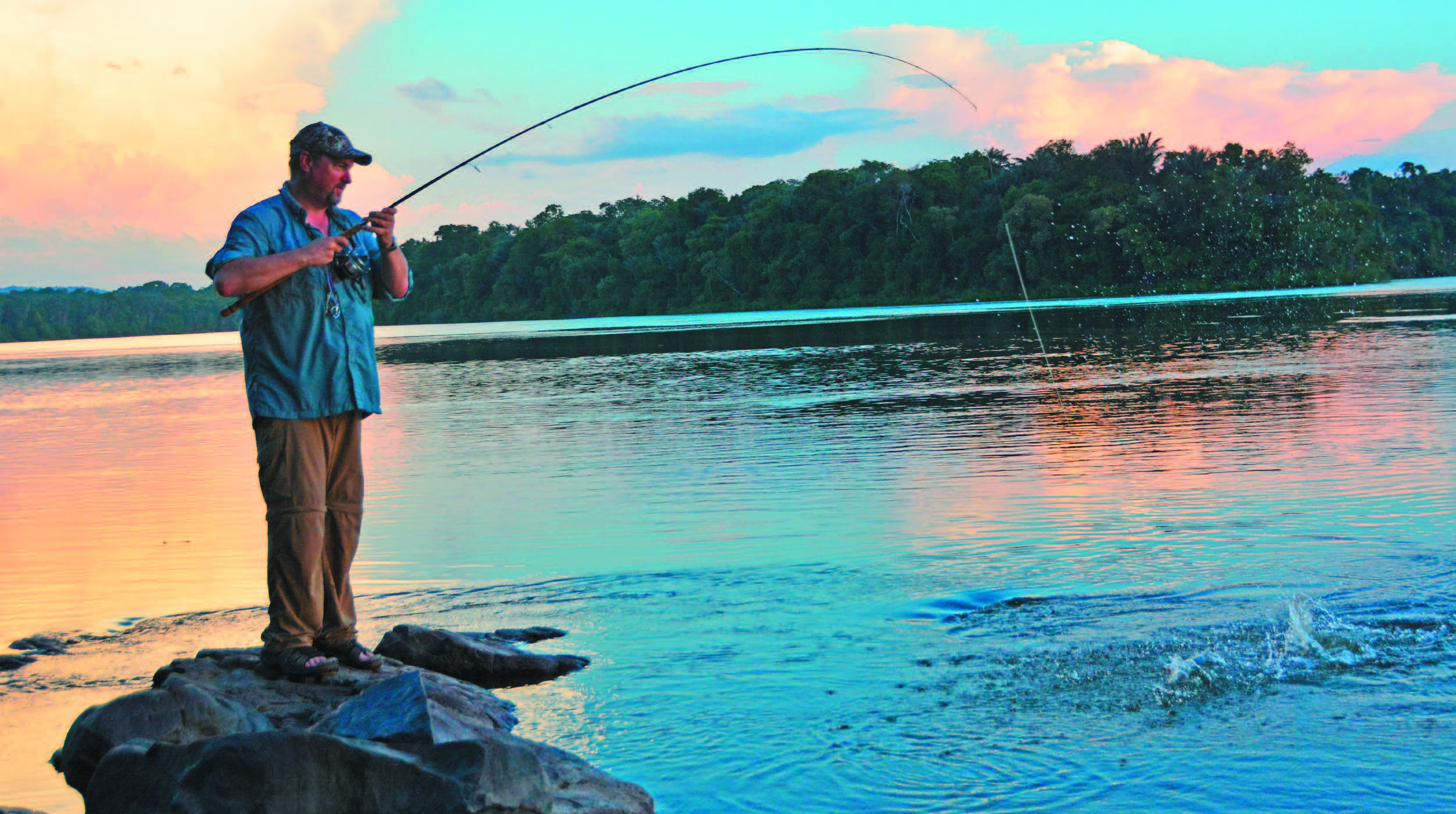
Only by fishing in the Amazon can you catch 29 different species of gamefish, but the ones everyone wants most are the arapaima and the paraiba.
Kenny, our Amerindian guide, was in a foul humor. When asked what the problem was, he replied, “A damn caiman ate my raincoat.”
For some reason I found that uproariously funny and broke out laughing. Soon, Kenny began laughing as did all his fellow guides. With that bit of drama out of the way, the anglers at Jaguar Explorer camp on Guyana’s Essequibo River piled into our boats for another day’s adventure.
There were six of us in all, four Brits and two Daves from the U.S.A. We met in Georgetown, where we caught a bush plane to a remote village and from there made our way up the Essequibo in a flotilla of small boats, about 25 miles to our camp on the riverbank. Camp consisted of a cluster of small tents, one per person, a common dining table, a loo, as our English friends called it, and a shower . . . of sorts.
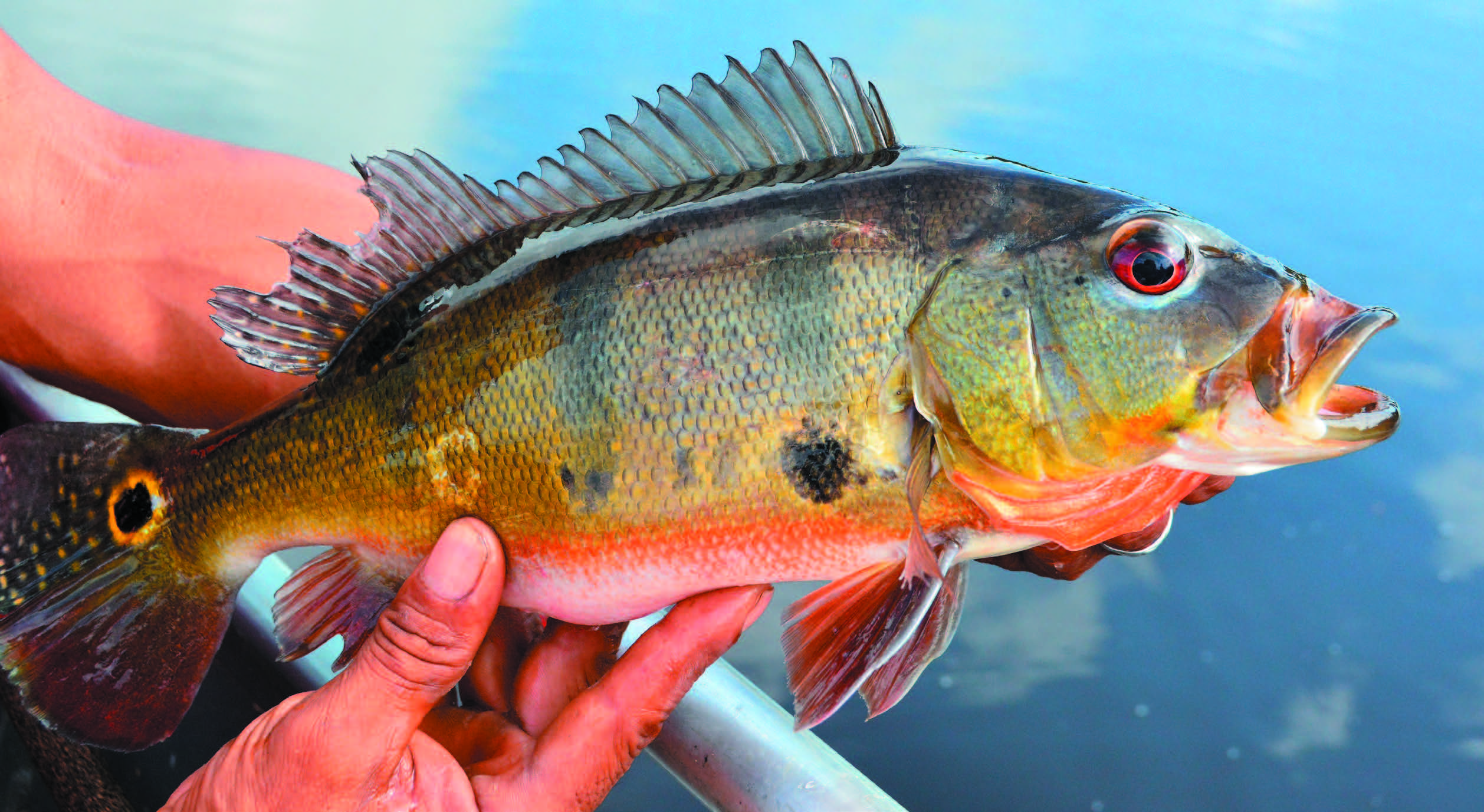
The first night in camp we were visited by howler monkeys, perhaps the noisiest and most threatening sound one can hear in the jungle, unless you understand they are usually harmless. But their howls, which sound like a cross between the bark of a huge dog and a lion’s roar is always unsettling, and after several hours can become quite annoying.
None of us was overly concerned about the noisy monkeys, the accommodations or the food; we were there to experience the incredible fishing found only in the Amazon. We knew we’d have a shot at more than 29 species of gamefish, but the ones everyone wanted most were the arapaima and the paraiba, a giant catfish the locals called Lau Lau.
Jim Walters, one of the Brits, was keenly focused on dong battle with a Lau Lau, preferably one in the 200- to 300-pound class. Dave and I were hoping to cross the legendary arapaima and a giant paraiba from our bucket lists.
Each day two of us would go with a guide to fish for whatever we might want to target. Peacock bass were relatively easy to catch as were piranha, both the pan-fish-sized red piranha and the brutish black piranha that can reach 10 pounds. Most of us set our aim for either Lau Lau or arapaima with other species as incidental catches.
The camp was scheduled for nine days, which gave us plenty of time to pursue our targets. We were warned it might take a good bit of time, patience and skill to hook and land an arapaima or a big paraiba, though for very different reasons.
Dave and I chose to try Lau Lau first. Kenny took us 12 miles downriver to a small tributary called the Siparuni. We arrived at a deep, languid pool and began what was to become an oft-repeated ritual. We baited size 12/0 circle hooks on a 100-pound-test leader attached to 140-pound-test braid, then switched the reels to free spool, paddled over to the jungle’s edge to find a bit of shade and waited for a bite. The drill was very simple; landing a Lau Lau not so much.
Occasionally a piranha would nibble at the bait and get us excited, but Kenny said, “You will know when it’s a Lau Lau.”
Sure enough, after an hour, Dave’s reel began a slow, but steady click, click, clickas the line began moving upstream.
“Strike,” Kenny screamed.
Dave did and immediately something huge began peeling off line, even though the drag was locked down as far as it would go.
For a millisecond I thought, Well dang, this is going to be easy. Then the line stopped moving and Dave could no longer feel life on the other end. The big cat had sought refuge in one of the many deep crevices on the river bottom. Try as we might, we could not move him or even feel him. Eventually, we reluctantly broke the line and rerigged.
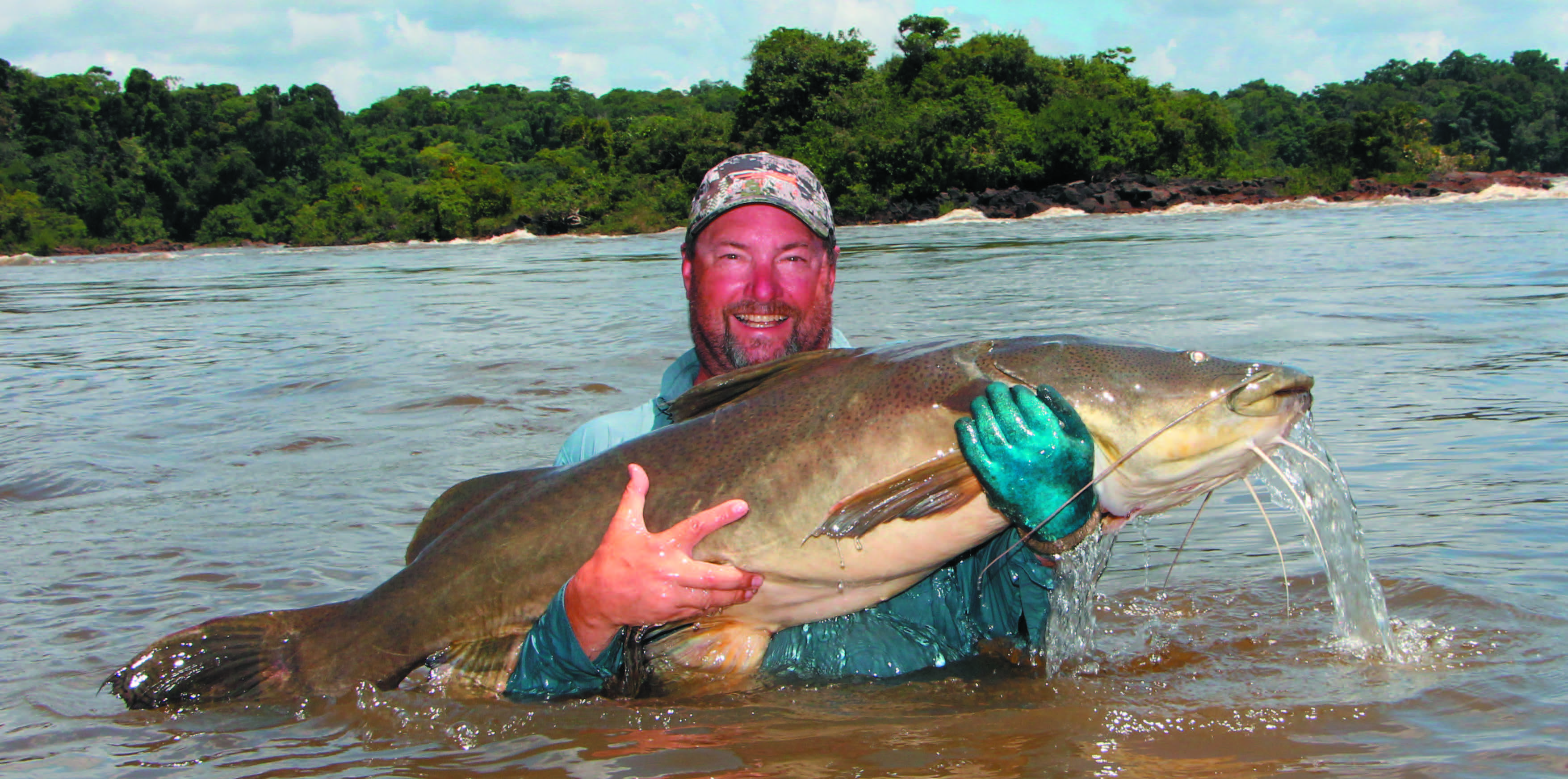
This was a scenario that played out too many times. The river is strewn with sunken logs, root wads and crevices. Hooking a Lau Lau was not difficult, but landing one another thing.
By day’s end, we had landed a 15-pound leopard catfish, a good-sized stingray, and a 50-pound red-tailed catfish. We now knew that putting a Lau Lau on the beach was not going to be easy, but that was okay with us. We were looking for an adventure, and we’d certainly found one!
Back at camp we learned that the British duo of Jamie and Jim had caught quite a variety of fish, including a huge black piranha, several peacock bass, a sunfish and assorted other smallish fish. They had seen several arapaimas but failed to coax one to the hook. The other British, couple Vivian and Dave, did about the same, but Viv managed to land a very respectable payara, another of my bucket list fish.
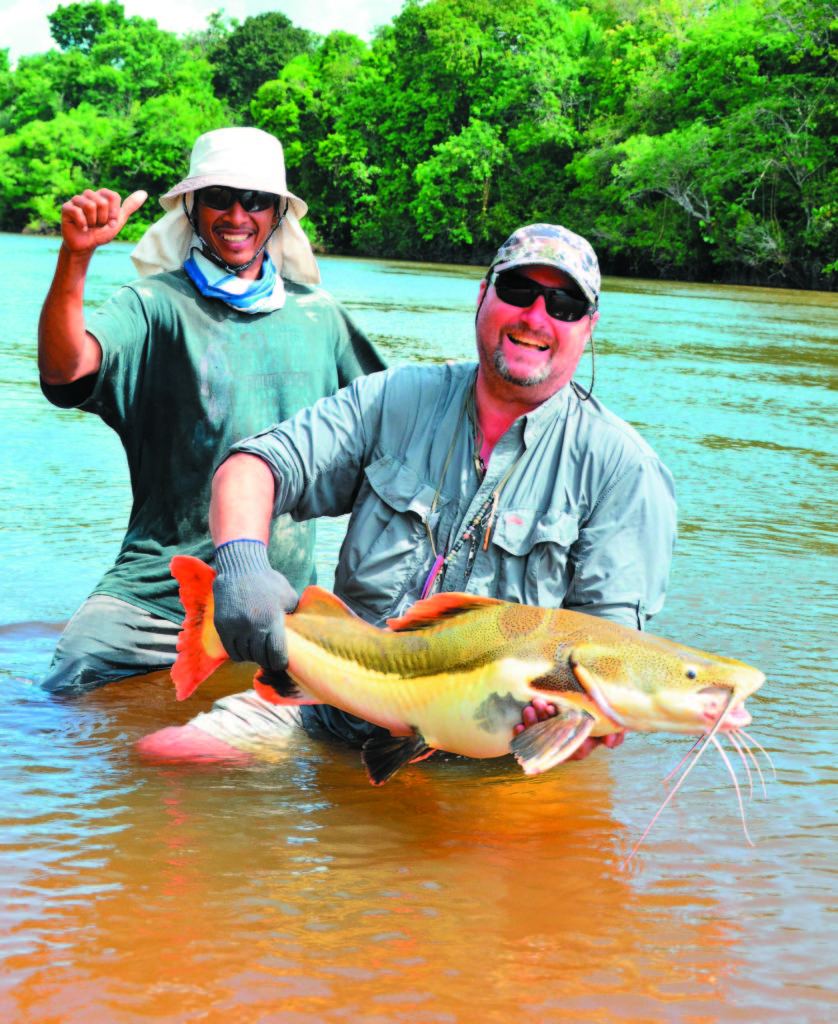
Later that evening, one of the guides came up to Kenny and said, “I found your raincoat. A caiman up the Sipiruni River was wearing it.”
Again we all had a good laugh. But caiman in this region are no laughing matter. Most of the world’s caiman are three to four feet long, but not those in Guyana where black caiman can reach 17 feet in length and they have taken human lives. There is no danger to anglers in motorboats, but Kenny said he personally knew of two children eaten by large caiman and later in our trip, we met a man who had lost an arm to one of these giant predators.
Each day we hit the river hoping for a paraiba or an arapaima, though confident we would catch many other kinds of fish. We hooked at least a dozen Lau Lau in the first two days. Many broke us off on debris on the bottom, one broke a rod, two snapped leaders and one, which we estimated at 150 pounds, stayed on for an epic battle that ended with the hook pulling out.
We found plenty of time to chat while waiting for a strike in our small boat. One day I asked Kenny if the local people had any superstitions. He assured me that they are not a superstitious people. But then, after a few minutes, he asked if we knew about the River Die Die. He explained that it is a human-like creature, seven feet tall, very thin and oddly enough, possessing no rectum.
The Die Die apparently communicates by knocking limbs against tree trunks. Kenny warned us not to be thumping tree trunks, as it might send a bad vibe to the Die Die. He told us they occasionally kill and eat people, but never a “white guy.” We also learned that the Die Die has horrendous breath, perhaps because he must vomit up whatever he eats, as there is no other exit for digested food.
While discussing the man-eating Die Die, Kenny casually mentioned that he is only three generations removed from tribes that indulged in cannibalism. This is truly one of the last regions to largely escape the path of “progress.”
We were surprised at how little traffic we saw on the river. There was the occasional motorboat and, less frequently, dugout canoes, often loaded with an entire family. Kenny told us there were no villages upstream, which explained why the traffic was so light. We did see several gold prospectors—lone men who camp in the jungle as long as a month at a time while prospecting for the huge nuggets occasionally found there. They carried metal detectors, sweeping the jungle floor in hopes of finding a nugget that could be a life-changer.
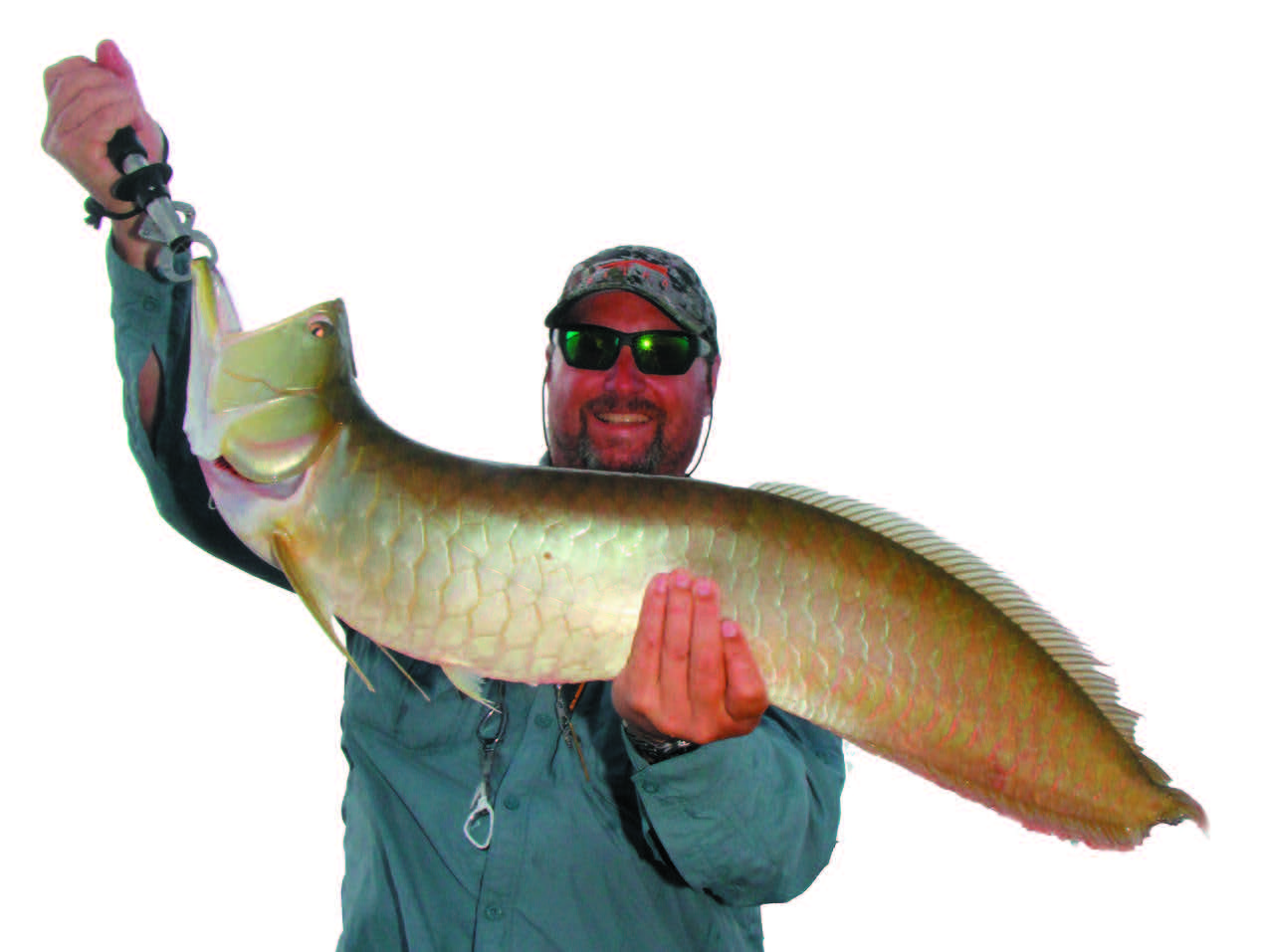
Often while sitting at the jungle’s edge waiting for a bite, the jungle denizens would serenade us. From high in the canopy a small bird would make a trilling call and then another would join in. Soon a cacophony of sounds would envelop us. Then, as if someone threw a switch, the jungle would go as silent as a tomb. One day I wandered well back into the jungle just to see what it was like. Under the dense canopy of towering trees, the jungle is dark, even at noon, but it’s alive with insects, frogs, small mammals and even the rarely seen jaguar.
After a few days of exploring the region near camp, Kenney asked if we wanted to try some pools farther downriver where many big Lau Lau have been hooked. Naturally, we were eager to go. The trip downriver was the stuff of dreams. We glided across long stretches of placid water where the current was barely discernible, occasionally passing one of the half-dozen gold dredges working the area. The river picked up speed as we entered a narrow canyon and soon we were zipping down rapids that many whitewater enthusiasts would be unwilling to test. All we had was our smallish outboard . . . and Kenny.
Kenny and the other guide were superb boatmen, which makes sense considering the river is their home, their highway and their key to survival in the small jungle communities. Twice Kenny pulled over to have us walk around challenging rapids, while he ran the boat through. Dave and I were in awe as we watched him thread his narrow boat through raging, tea-colored water where he quickly found a route unseen by us.
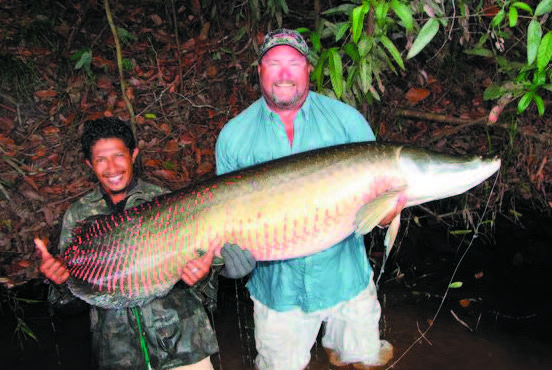
We finally arrived at the head of an enormous pool that definitely looked like big fish water. The pool was large enough to hold a monster-class fish and the surging current created numerous ambush points for a fish big enough to gobble down a 30-pound “baitfish.”
Kenny motored to the edge to the pool, which we estimated to be 45 feet deep. Once again we dropped baits and free-spooled line as we made our way to the only speck of shade along the beach. Almost immediately my line began moving, at first slowly, then rapidly. Before Kenny could urge me to strike, I struck hard, three times in a row. Something huge surged away, and I leaned back to put all the pressure I could on the leviathan.
Suddenly, the line went slack and I fell over backward across the gunnel and into the river. The momentum of my fall knocked Dave off his seat and he, too, fell backward. Fortunately, Dave and Kenny knew that the boat would sink if all three of us had our weight on the same side. Thinking fast, they both leaped out so the boat could right itself. Then, after a good bit of scrambling, we climbed back into the boat. All that was lost was a huge fish, a rod and my dignity. I must admit I was thinking about piranha while I was scrambling to get back into the boat.
We set up again and were again met with an almost instant bite. This time it was Dave’s turn. He did everything right and hooked a good-sized fish. Kenny kept the boat positioned above the big cat, giving Dave his best shot at keeping it out of the crevasses on the bottom. After a 20-minute tug of war under the blazing Amazon sun, Kenny was able to lip Dave’s catch. It was Jau Jau, a brutish looking catfish of about 90 pounds. A great catch, but not what we were after.
We stayed at the pool for another three hours and hooked at least 10 big cats. We landed a 70-pound red-tailed catfish, which was a striking black, red and yellow, and several more Jau Jau weighing from 30 to 70 pounds.
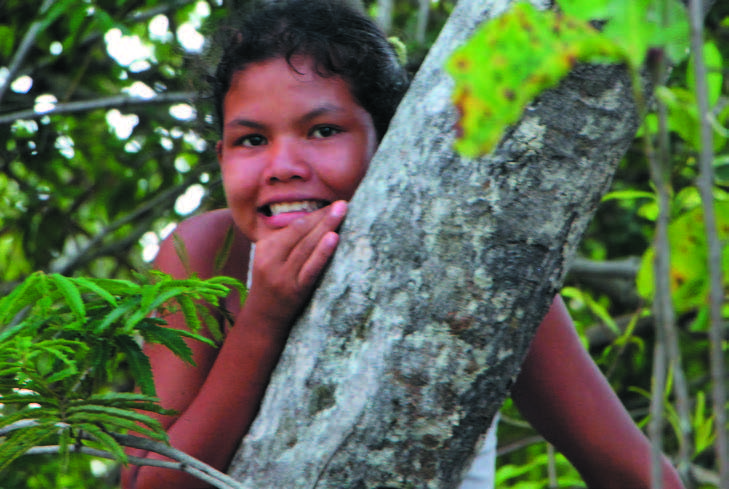
Dave tied into something obviously bigger than anything we’d hooked before. For about ten minutes we thought Dave might best it, but eventually the huge catfish made its way into a crevasse on the bottom and sawed off Dave’s line. Despite losing that monster fish, we were undaunted. It was obvious our quarry was there and we were certain we would eventually best a trophy Lau Lau. We agreed that we needed to return another day.
That evening, Kenny came to ask if we wanted to try for arapaima the next day. He needed to know so he could go out that night for a special baitfish. We agreed that it was time to take on one of the Amazon’s biggest challenges, a the prehistoric fish that looks like a strange cross between a pike and an eel, weighs up to 600 pounds, breathes air, and that is losing its home range to logging and commercial fishing.
We motored up to the mouth of a long, narrow slough perhaps ten miles upriver. Kenny killed the motor and began slowly paddling toward the center of the slough. He whispered for us to sit quietly while looking for telltale bubbles that indicate the presence of an arapaima.
Within minutes we saw the surface of the slough bulge as an arapaima surfaced for a gulp of air. Kenny immediately began paddling toward the fish and I grabbed my casting rod. We were able to track the fish for more than 100 yards by watching the bubble trail.
Then Kenny whispered: “Cast your bait fifty feet in front of the bubbles.”
I did as instructed and waited with my pulse pounding and my adrenaline levels soaring. Slowly my line began moving away and I got ready to strike.
Suddenly, Kenny hissed, “Wait. Wait!”
After a seeming eternity that was probably only 15 seconds, Kenny shouted “Now!” and I set the hook as hard as humanly possible.
The arapaima leaped the instant it felt the sting of the hook. Once, twice, three times, the massive fish leapt. It almost seemed as if it was trying to show us what we had chosen to tangle with. Next, the seven-foot monster dove and began sulking on the bottom. I could coax it up a few feet, but it would immediate take back all I had gained and sometimes a bit more. After more than 40 minutes, I could tell the huge fish was tiring. Each dash for freedom was a bit shorter than the last and it was getting a bit easier to turn him back toward the boat.
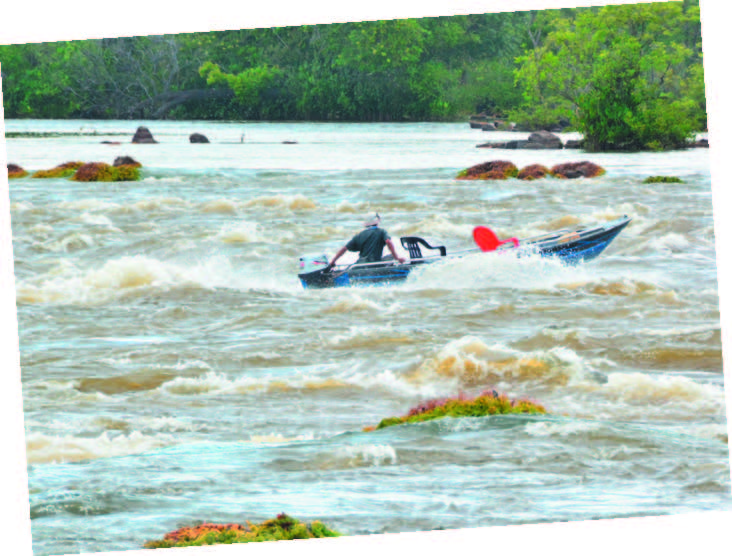
Finally, we had the behemoth to the boat where we all marveled at its size, distinctive coloration and prehistoric appearance. With great care Kenny took us to the shore for a few quick photos, before very gently unhooking our very worthy adversary. Kenny took more than ten minutes to gently revive the fish. When he felt it was ready to release, he swam underwater with it for perhaps 50 feet to be sure it had its equilibrium and was able to return safely to its deep-water haunt.
After the obligatory high fives and a celebratory warm beer, Kenny asked if we wanted to try for another. Dave and I agree we had experienced the magic of the arapaima and didn’t need to harass another one. Instead, we chose to focus on some of the other smaller but still spectacular gamefish in the area.
As we neared camp that evening, we noticed a school of fish crashing bait in a shallow bay surrounding a low-lying island. I put on a five-inch popper and cast into the melee. Instantly, something slammed the popper, knocking it 20 feet away. When it hit the water for the second time, something big and ornery inhaled the plug. It immediately began a series of cartwheels while putting up an amazing aerial fight.
“These are arawanna,” Kenny announced. Before I could land my fish, Dave was into one of his own. For the next hour, we hooked and released one arawanna after another, all in the 8- to 15-pound class. Kenny told us the arawanna are inclined to strike topwater plugs because they often take birds and other small creatures that venture close to the surface.
As our trip came to an end, safari owner Steve Townson took a tally of how many species we’d landed. The final count was 29! Everyone had caught at least one of their bucket list fish and everyone swore they would return. Many times those promises to return are hard to keep. But in this case, four of the six of us have already rebooked.
I never did get my trophy Lau Lau, but I made contact and I know it’s just a matter of time. The Essequibo is definitely lousy with these freshwater behemoths. Next time, I’ll bring heavier gear, better hooks, stronger line and the Lau Lau will be mine. It’s just a matter of getting back to Guyana.
